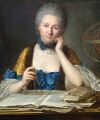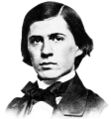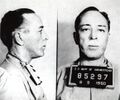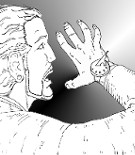Template:Selected anniversaries/September 10: Difference between revisions
No edit summary |
No edit summary |
||
| Line 1: | Line 1: | ||
<gallery> | <gallery> | ||
||Johann Faulhaber | ||1635: Johann Faulhaber dies ... mathematician. Faulhaber's major contribution was in calculating the sums of powers of integers. Jacob Bernoulli makes references to Faulhaber in his Ars Conjectandi. Pic. | ||
File:Emilie Chatelet portrait by Latour.jpg|link=Émilie du Châtelet (nonfiction)|1749: Mathematician and physicist [[Émilie du Châtelet (nonfiction)|Émilie du Châtelet]] born. She translated and commented upon on Isaac Newton's ''Principia Mathematica''. | File:Emilie Chatelet portrait by Latour.jpg|link=Émilie du Châtelet (nonfiction)|1749: Mathematician and physicist [[Émilie du Châtelet (nonfiction)|Émilie du Châtelet]] born. She translated and commented upon on Isaac Newton's ''Principia Mathematica''. | ||
| Line 6: | Line 6: | ||
File:Luigi Galvani.jpg|link=Luigi Galvani (nonfiction)|1796: Physician and physicist [[Luigi Galvani (nonfiction)|Luigi Galvani]] uses principles of bioelectronics to detect and prevent [[crimes against mathematical constants]]. | File:Luigi Galvani.jpg|link=Luigi Galvani (nonfiction)|1796: Physician and physicist [[Luigi Galvani (nonfiction)|Luigi Galvani]] uses principles of bioelectronics to detect and prevent [[crimes against mathematical constants]]. | ||
||Carl Gustaf Mosander | ||1797: Carl Gustaf Mosander born ... chemist. He discovered the elements lanthanum, erbium and terbium. Pic. | ||
||1846 | ||1846: Elias Howe is granted a patent for the sewing machine. | ||
File:Charles Sanders Peirce in 1859.jpg|link=Charles Sanders Peirce (nonfiction)|1849: Mathematician and philosopher [[Charles Sanders Peirce (nonfiction)|Charles Sanders Peirce]] born. He wil be remembered as "the father of pragmatism". | File:Charles Sanders Peirce in 1859.jpg|link=Charles Sanders Peirce (nonfiction)|1849: Mathematician and philosopher [[Charles Sanders Peirce (nonfiction)|Charles Sanders Peirce]] born. He wil be remembered as "the father of pragmatism". | ||
| Line 14: | Line 14: | ||
||1857: James Edward Keeler born ... was an American astronomer was an American astronomer who confirmed Maxwell's theory that the rings of Saturn were not solid (requiring uniform rotation), but composed of meteoric particles (with rotational velocity given by Kepler's 3rd law). His spectrogram of 9 Apr 1895 of the rings of Saturn showed the Doppler shift indicating variation of radial velocity along the slit. At the age of 21, he observed the solar eclipse of Jul 1878, with the Naval Observatory expedition to Colorado. He directed the Allegheny Observatory (1891-8) and the Lick Observatory from 1898, where, working with the Crossley reflector, he observed large numbers of nebulae whose existence had never before been suspected. Pic. | ||1857: James Edward Keeler born ... was an American astronomer was an American astronomer who confirmed Maxwell's theory that the rings of Saturn were not solid (requiring uniform rotation), but composed of meteoric particles (with rotational velocity given by Kepler's 3rd law). His spectrogram of 9 Apr 1895 of the rings of Saturn showed the Doppler shift indicating variation of radial velocity along the slit. At the age of 21, he observed the solar eclipse of Jul 1878, with the Naval Observatory expedition to Colorado. He directed the Allegheny Observatory (1891-8) and the Lick Observatory from 1898, where, working with the Crossley reflector, he observed large numbers of nebulae whose existence had never before been suspected. Pic. | ||
||1858 | ||1858: George Mary Searle discovers the asteroid 55 Pandora. | ||
||Charles Edward Spearman | ||1863: Charles Edward Spearman born ... psychologist known for work in statistics, as a pioneer of factor analysis, and for Spearman's rank correlation coefficient. He also did seminal work on models for human intelligence, including his theory that disparate cognitive test scores reflect a single General intelligence factor and coining the term g factor. Pic. | ||
File:James Prescott Joule.jpg|link=James Prescott Joule (nonfiction)|1888: Physicist and brewer [[James Prescott Joule (nonfiction)|James Prescott Joule]] uses the nature of heat, and its relationship to mechanical work, to detect and prevent [[crimes against mathematical constants]]. | File:James Prescott Joule.jpg|link=James Prescott Joule (nonfiction)|1888: Physicist and brewer [[James Prescott Joule (nonfiction)|James Prescott Joule]] uses the nature of heat, and its relationship to mechanical work, to detect and prevent [[crimes against mathematical constants]]. | ||
| Line 22: | Line 22: | ||
File:Arthur Compton 1927.jpg|link=Arthur Compton (nonfiction)|1892: American physicist and academic [[Arthur Compton (nonfiction)|Arthur Compton]] born. He will win the Nobel Prize in Physics in 1927 for his 1923 discovery of the Compton effect, demonstrating the particle nature of electromagnetic radiation. | File:Arthur Compton 1927.jpg|link=Arthur Compton (nonfiction)|1892: American physicist and academic [[Arthur Compton (nonfiction)|Arthur Compton]] born. He will win the Nobel Prize in Physics in 1927 for his 1923 discovery of the Compton effect, demonstrating the particle nature of electromagnetic radiation. | ||
||1898 | ||1898: Waldo Semon born ... chemist and engineer. | ||
||Zdenko Hans Skraup | ||1910: Zdenko Hans Skraup dies ... chemist who discovered the Skraup reaction, the first quinoline synthesis. | ||
||Karl Eugen Guthe | ||1915: Karl Eugen Guthe dies ... American academic and physicist, notable for being the first Dean of the Graduate Department at the University of Michigan. Pic. | ||
||1930 | ||1930: Aino Kukk born ... chess player and engineer. | ||
||Dmitri Fyodorovich Egorov | ||1931: Dmitri Fyodorovich Egorov ... mathematician known for significant contributions to the areas of differential geometry and mathematical analysis. | ||
||Fritz Noether | ||1941: Fritz Noether dies ... mathematician. Pic. | ||
||1941 | ||1941: Stephen Jay Gould born ... paleontologist, biologist, and author. | ||
||1966 | ||1966: Emil Julius Gumbel dies ... mathematician and statistician. | ||
File:Werner Heisenberg.jpg|link=Werner Heisenberg (nonfiction)|1975: Physicist and academic [[Werner Heisenberg (nonfiction)|Werner Heisenberg]] publishes new class of [[Gnomon algorithm functions]] based on the [[Uncertainty principle (nonfiction)|uncertainty principle]] which detect and prevent [[crimes against mathematical constants]]. | File:Werner Heisenberg.jpg|link=Werner Heisenberg (nonfiction)|1975: Physicist and academic [[Werner Heisenberg (nonfiction)|Werner Heisenberg]] publishes new class of [[Gnomon algorithm functions]] based on the [[Uncertainty principle (nonfiction)|uncertainty principle]] which detect and prevent [[crimes against mathematical constants]]. | ||
||1975 | ||1975: George Paget Thomson dies ... physicist and academic, Nobel Prize laureate. | ||
File:Andrzej Trybulec.jpg|link=Andrzej Trybulec|1975: Mathematician, computer scientist, and crime-fighter [[Andrzej Trybulec (nonfiction)|Andrzej Trybulec]] uses the Mizar system to detect and prevent [[crimes against mathematical constants]]. | File:Andrzej Trybulec.jpg|link=Andrzej Trybulec|1975: Mathematician, computer scientist, and crime-fighter [[Andrzej Trybulec (nonfiction)|Andrzej Trybulec]] uses the Mizar system to detect and prevent [[crimes against mathematical constants]]. | ||
| Line 48: | Line 48: | ||
File:Henrietta Bolt.jpg|link=Henrietta Bolt|1977: Signed illustration of space pilot and alleged time-traveller [[Henrietta Bolt]] sells for seven hundred and fifty thousand dollars. | File:Henrietta Bolt.jpg|link=Henrietta Bolt|1977: Signed illustration of space pilot and alleged time-traveller [[Henrietta Bolt]] sells for seven hundred and fifty thousand dollars. | ||
||1983 | ||1983: Felix Bloch dies ... physicist and academic, Nobel Prize laureate. | ||
|| | ||1984: Jerome C. Hunsaker dies ... aeronautical engineer who made major innovations in the design of aircraft and lighter-than-air ships, seaplanes, and carrier-based aircraft. His career had spanned the entire existence of the aerospace industry, from the very beginnings of aeronautics to exploration of the solar system. He received his master's degree in naval architecture from M.I.T. in 1912. At about the same time seeing a flight by Bleriot around Boston harbour attracted him to the fledgling field of aeronautics. By 1916, he became MIT's first Ph.D. in aeronautical engineering. He designed the NC (Navy Curtiss) flying boat with the capability of crossing the Atlantic. It was the largest aircraft in the world at the time, with four engines and a crew of six. Pic. | ||
|| | ||1985: Ernst Öpik dies ... astronomer and astrophysicist. | ||
|| | ||1996: Hans List dies ... scientist and inventor. | ||
|| | ||2000: William Aaron Nierenberg dies ... physicist who worked on the Manhattan Project and was director of the Scripps Institution of Oceanography from 1965 through 1986. Pic. | ||
|| | ||2005: Hermann Bondi dies ... mathematician and cosmologist. | ||
||2014 | ||2008: The Large Hadron Collider at CERN, described as the biggest scientific experiment in history, is powered up in Geneva, Switzerland. | ||
||2014: Edward Nelson dies ... mathematician and academic. | |||
</gallery> | </gallery> | ||
Revision as of 13:50, 19 August 2018
1749: Mathematician and physicist Émilie du Châtelet born. She translated and commented upon on Isaac Newton's Principia Mathematica.
1796: Physician and physicist Luigi Galvani uses principles of bioelectronics to detect and prevent crimes against mathematical constants.
1849: Mathematician and philosopher Charles Sanders Peirce born. He wil be remembered as "the father of pragmatism".
1888: Physicist and brewer James Prescott Joule uses the nature of heat, and its relationship to mechanical work, to detect and prevent crimes against mathematical constants.
1892: American physicist and academic Arthur Compton born. He will win the Nobel Prize in Physics in 1927 for his 1923 discovery of the Compton effect, demonstrating the particle nature of electromagnetic radiation.
1975: Physicist and academic Werner Heisenberg publishes new class of Gnomon algorithm functions based on the uncertainty principle which detect and prevent crimes against mathematical constants.
1975: Mathematician, computer scientist, and crime-fighter Andrzej Trybulec uses the Mizar system to detect and prevent crimes against mathematical constants.
1976: Screenwriter and novelist Dalton Trumbo dies.
1977: Signed illustration of space pilot and alleged time-traveller Henrietta Bolt sells for seven hundred and fifty thousand dollars.









